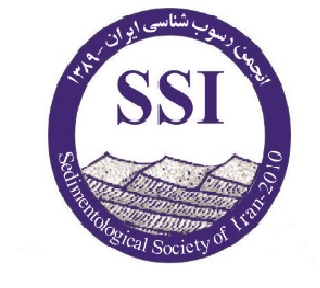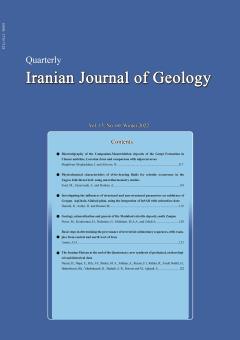Biostratigraphy of the Campanian-Maastrichtian deposits of the Gurpi Formation in Chenar anticline, Lorestan Zone and comparison with adjacent areas
Subject Areas :Iraj Maghfori-Moghaddam 1 * , ندا افروزه 2
1 -
2 -
Keywords: Chenaereh anticline, Biostratigraphy, Lorestan basin, Gurpi Formation, Masstrichtian.,
Abstract :
In this research, biostratigraphic studies of the Gurpi Formation were carried out at the Chenareh section (Lorestan Zone). The thickness of Gurpi Formation at the studied section is 140 m and consists of limestobe, marly limestone and marl. The Gurpi Formation conformablely (with significant lithological changes) underlies the white limestones of the Ilam Formation and is covered by the sandstone of the Amiran Formation. On the basis of the recognized planktonic foraminifera, 7 biozone were reported as follows: Globotruncanita elevata Partial range Zone (Early Campanian), Globotruncana ventricosa Interval Zone (Middle to Late Campanian), Radotruncana calcarata Total Range Zone (Late Campanian), Globotruncanella havanensis Partial Range Zone (Late Campanian), Globotruncana aegyptiaca Interval Zone (Late Campanian), Gansserina gansseri Interval Zone (Late Campanian-Early Masstrichtian), Contusotruncana contusa Interval Zone (Late Masstrichtian). In the studied section, the Seymareh and Imam Hassan sections are not observed, unlike other sections in the Lorestan basin. The thickness of this formation in Chenareh anticline is much less than other sections in the adjacent areas.
- اصغریان، رستمی، م.، 1391. مطالعه زیست چینه نگاری و جغرافیای دیرینه سازند گورپی در برش میش خاص، جنوب خاور ایلام، با استفاده از روزن بران. فصلنامۀ علوم زمین، 22( 85)، 148-135.
- رحیمی ، س.، آشوری، ع. ر.، صادقی، ع. و قادری، ع.، 1397. زیست چینه نگاری سازند گورپی بر مبنای روزنداران پلانکتون در برش گنداب و تطابق آن با برش نمونه، تاقدیس کبیر کوه، جنوب غرب ایران. پژوهشهای چینه نگاری و رسوبشناسی، 34(3) ،52-37.
صادقی، ع. و دارابی، ق.، 1394. بایوستراتیگرافی سازند گورپی در میدان نفتی مارون، پژوهشهای چینه نگاری و رسوبشناسی، 31(6)، 19-36.
- فریدونپور، م.، وزیری مقدم، ح.، غبیشاوی، ع. و طاهری، ع.، 1394. چینه نگاری سازند گورپی در برش تاقدیس کوه سیاه و مقایسه آن با برشهای تنگ بوالفارس و تاقدیس آغار. رخسارههای رسوبی، 7(1)، -106-83.
-مطیعی، همایون.، 1374. زمینشناسی نفت زاگرس، سازمان زمینشناسی کشور، جلد اول ، طرح تدوین کتاب زمینشناسی ایران، 1009.
- مغفوری مقدم، ا.، دارابی، ق.، سولگی، ز.،1396. زیست چینه نگاری سازند گورپی در تاقدیس زنگول و مقایسه آن با برش کوه سیاه، برش عسلویه و چاه ایوان، یافتههای نوین زمینشناسی کاربردی، 11(22)،64-49.
- همتی نسب،م.، قاسمی نژاد،ا. و درویش زاده، ب.،1387. تعیین عمق دیرینهی سازند گورپی بر مبنای فرامینیفرهای پلانکتونیک و بنتیک، مجله علوم دانشگاه تهران، 37(1)، 173-157.
-Abramovich, S., Keller, G., Stuben, D. and Berner, Z., 2003, Characterization of late Campanian and Maastrichtian planktic foraminiferal depth habitats and vital activities based on stable isotopes. Palaeogeography, Palaeoclimatology, palaeoecology, 202, 1- 29.
-Alavi, M., 2004. Regional stratigraphy of the Zagros foldthrust belt of Iran and its proforeland evolution. American Journal of Science, 304, 1–20.
-Darabi, D., Maghfouri Moghaddam, I., Sadeghi A. and Yusefi, B., 2018. Planktonic foraminifera and sea-level changes in the upper Cretaceous of the Gurpi Formation, Lorestan basin, SW Iran .Journal of African Earth Sciences, 138, 201-218.
-Falcon, N.L., 1961. Major earth-flexuring in the Zagros Mountains of south-west Iran, Quarterly Journal of the Geological Society of London, 117, 367–376.
-Farzeipour-Saein, A., Yassaghi, A., Sherkati,S. and Koyi, H., 2009. Basin evolution of the Lurestan Region in the Zagros Fold- and-Thrust belt, Iran. Journal of Petroleum Geology, 32, 5-20.
- Hart, B. M. and Baily, H. W., 1979. The distribution of the planktonic foraminifera in the mid-Cretaceous of new Europe. Aspekt, der kriede, IUGS. Series, 6,527-542.
-Homke, S., Verges, J., Serra-Kiel, J., Bernaola, G., Sharp, I., Garces, M., Montero-Verdu, I., Karpuz, R. and Goodarzi, M.H., 2009. Late Cretaceous- Paleocene formation of the proto-Zagros foreland basin, Lurestan Province, SW Iran. Geological Society American Bulletin, 121(7–8):963–978.
-Honarmand, A., Vahidnia, M. and Mahmudy Gharaie, M. H., 2020. Biostratigraphy of the Gurpi Formation (Zagros Basin, Western Iran) based on planktonic foraminifera. Geologica Balcanica, 49(1), 53-66.
-James, G.A. and Wynd, J.G., 1965. Stratigraphic nomenclature of Iranian Oil Consortium Agreement Area: The American Association of Petroleum Geologists Bulletin, 49, 2182–2245.
Liewellyn, V. P. G., 1974. Geological map of Ilam- Kuh Dast, 1:250 000, N.I.O.C.
Permoli Silva, I. and Verga, D., 2004. Practial Manual of Crataceous Planktonic foraminifera. International school on Planktonic foraminifera. University of Perugia, 283.
-Martinez, J.I., 1989. Foraminiferal biostratigraphy and paleoenvironmments of the Maastrichtian Colon mudstones of Northern Southe America. Micropaleontology, 35, 97-113.
-Vaziri-Moghaddam, H., 2002. Biostratigraphic study of the Ilam and Gurpi formations based on planktonic foraminifera in SE of Shiraz, Iran. Journal of Sciences, Islamic Republic of Iran, 13(4), 339-356.
-Wynd, J.G., 1965. Biofacies of Iranian oil ConsortiumAgreement Area, (I.O.O.C) Report No.1082 (Unpublished paper), 88.

